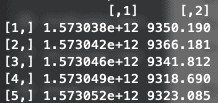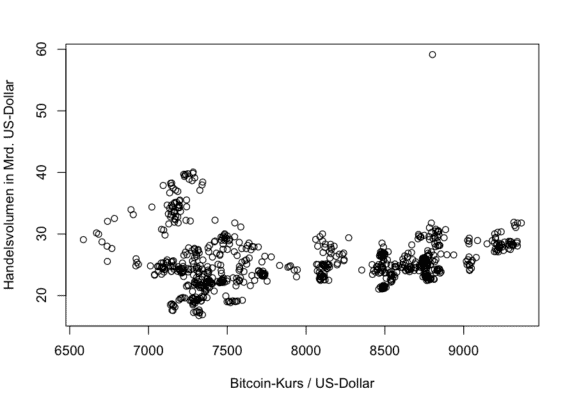How to read a Bitcoin-Interested stories from the data? And where to find useful data? The first steps to do this should be explained in the article.
Closely with the crypto-scene connected to the Motto: Don’t trust, verify. Trust is not easy to check. An attitude reflected also in the Bitcoin Ecosystem well-known abbreviation DYOR (Do your own research) is reflected. It is not simply a disclosure, but rather, to make every BTC-ECHO-readers of a Mature crypto-citizens. Therefore, to be presented in this article, two of the sources of the data used. For today, we are focusing on Bitcoin.
A word ahead: For the data analysis, I use the programming language R. if you want to learn about the powerful statistical programming language can learn in this Video a little more. All in the further course of these data sources are, however, also with other Tools such as Python, are available.
Trading view: Excellent source of raw data
Trading view is the Bitcoin scene as well. The course analyses in our website are generally carried out with the help of this powerful platform. Trading view is a fantastic platform to Create Charts. What few know: A first step to Juggling data can be Export trading view data. So trading view with Pine has a powerful programming language that we introduced in in this article.
What is, however, if you want to combine external data with the trading view data? For this purpose, the platform provides for a few months, the possibility of the data export. A click allows it to export both the Bitcoin exchange rate as well as all of the indicators in the Layout as a csv file:
CSVFiles are tables in which all values in a row are separated by commas. You get an easy-to-read Format that can be imported into Excel or similar.
The Analyst-in-law can now work with these data. In R, he would be able to be read with a simple command:
daten <- read.csv("Pfad/zum/Dateinamen.csv")
Of course there are other possibilities. Many Fans of R to swear Tidyversea group of libraries for R, which facilitates Working with data is extremely. The Tidyverse is reflected in particular in the Bitcoin Reports. It would, however, go beyond the framework of this report.
Juggling with Bitcoin exchange rate data of Coingecko
A disadvantage with the above approach: processes cannot be automated. Why work with programming languages if you have to click for the further processing of the data three times? Here is a more direct access to the courses would be helpful.
To do this, it goes to the analysts of Bitcoin & co. is often not easy courses. The development of Supply and market capitalization is always in the focus of the analysis. While it can help here also trading view and the amount of available data is getting bigger and bigger. However, analysts have to rely on additional data sources.
Here, in many Places, Working with the programming interfaces is the so-called APIs. API stands for Application Programming Interface, and allows you to, simply spoken, the access to the data from the command line or from a program. Coingecko is an example of such a platform with API. The Pleasant: Currently, you do not need to register for this.
You want to ask about a history from the Bitcoin price reproducible, is the first step on a URL possible:
https://api.coingecko.com/api/v3/coins/bitcoin/market_chart?vs_currency=usd&days=30
The Problem is that The Format is slightly unusual. Unlike a CSV file, this so-called JSON Format not a simple table. Nevertheless, it is in R is quite easy to:
library(jsonlite)daten <- fromJSON("https://api.coingecko.com/api/v3/coins/bitcoin/market_chart?vs_currency=usd&days=30")
The Variable data will now contain three tables, each of the price, the market capitalization and the volume contained. Data$price, data$market_caps and data$total_volumes each of these tables can be further processed.
Anno 1970: Unix Time Format
For data$prices, the first five lines are as follows:

The second column is undoubtedly the (former) Bitcoin price, but what is the first? It is a of computers a good readable time indication, the Unix epoch. It is one from 1.1.1970 to zero o’clock in the morning in manageable units of time. For this purpose, seconds, or milliseconds are often, as in this case, counted.
Of course, can help us to convert this into something readable time:
as.POSIXct(daten$prices[,1]/1000,origin = "1970-01-01")
This command makes the Unix-epochs-readable time stamp:



We have now made the first step in the direction of the data analysis in the Bitcoin Ecosystem. Of course, we have only touched the surface. Things like On-chain data, we have not addressed even once. But any way, also of the crypto-analysts, begins with a first step. The above strategies can bring you a long way. Not only that, you can display price, market capitalization and trading volume of Bitcoin now, visually, you can also pay attention to the dependencies of the variables with each other. With this command:
plot(daten$prices[,2],daten$total_volumes[,2]/10^9,xlab="Bitcoin-Kurs / US-Dollar", ylab = "Handelsvolumen in Mrd. US-Dollar")
the Bitcoin-Analyst-in-law comes to this Chart:


Before one wonders about the relatively high volume of trade: To every time stamp Coingecko collects the trading volume of the last 24 hours.
Admittedly, This is not the first of the most exciting of all the Charts. We know now that it was within the last month, no real dependency between trading volume and Bitcoin price. But what I would like to identify this example: This is only the beginning of a route. One might ask whether there is a certain Lag between trading volume and rate, and the Code corresponding to rephrase. You could expand the API Call in such a way that you look at only data from the last thirty days. And what about the dependency between trading volume and the price at the other crypto-currencies?
You, dear reader, we wish you much fun and success with your own analysis. If you have to tell something interesting, it would be nice if you come with us and the Community in our Discord in the exchange step.
Display
Bitcoin, Ethereum, Ripple, IOTA in one App!
Reliable, Simple, Innovative – Germany’s most popular crypto-currencies easy and safe to trade.
The Advantages:
☑ Free 40.0000 EUR demo account
☑ Registration in just a few minutes
☑ PayPal Deposit/withdrawal possible
☑ Available 24/7 + mobile Commerce
To The Provider
76.4% of small investors ‘ accounts lose money in CFD trading with this provider [Anzeige].

